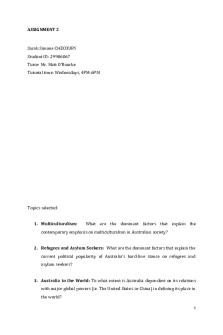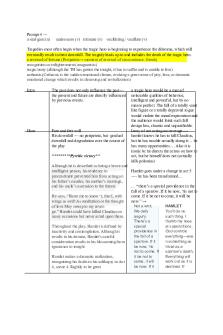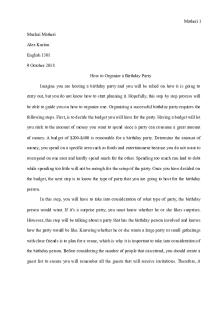ATS2269 Essay 2 PDF

| Title | ATS2269 Essay 2 |
|---|---|
| Author | Sarah Checoury |
| Course | Contemporary Australia |
| Institution | Monash University |
| Pages | 10 |
| File Size | 182 KB |
| File Type | |
| Total Downloads | 99 |
| Total Views | 142 |
Summary
Take-home exams: needed to pick 3 questions of 3 topic different.
...
Description
ASSIGNMENT 2
Sarah Simone CHECOURY Student ID: 29906067 Tutor: Mr. Matt O’Rourke Tutorial time: Wednesdays, 4PM-6PM
Topics selected:
1. Multiculturalism:
What are the dominant factors that explain the
contemporary emphasis on multiculturalism in Australian society?
2. Refugees and Asylum Seekers: What are the dominant factors that explain the current political popularity of Australia’s hard-line stance on refugees and asylum seekers?
3. Australia in the World: To what extent is Australia dependent on its relations with major global powers (ie. The United States or China) in defining its place in the world? 1
Topic 1 - Multiculturalism: What are the dominant factors that explain the contemporary emphasis on multiculturalism in Australian society? (561 words)
Multiculturalism represents the roots of modern Australia. To identify the main
influences on today’s multicultural Australian society, it is important to first understand what multiculturalism means and identify its differents facets. According to Van de Vivjer et al. (2008) multiculturalism can refer to three things:
a demographic
characteristic, a label to identify a policy regarding cultural diversity, or finally “an attitude toward the ideology of many cultures co-existing in mutual acceptance” (Arasaratnam, 2014). This essay will focus on this last aspect and more precisely on the factors that shifted these attitudes. To explain the increasing emphasis on Australian multiculturalism, three main factors have been identified: the rise of consciousness about current social issues concerning integrating more indigenous Australians, more migrants Australians and more Australian women inequalities. The changes in attitudes towards indigenous Australians, in other terms the increasing recognition of their rights and the discrimination they face, can be considered as a first factor. Multiculturalism can indeed be associated with the concepts of “recognition and equity”
between different ethnic groups, including minorities.
Therefore, this notion can be directly linked to the national debate concerning the meaningful recognition of land, language and cultural rights for Indigenous people (HREOC, 2000). After two centuries of “cultural holocaust” and racist Australian policies, such as brutal forced assimilation for the “Stolen Generation”, the voices of the indigenous are finally being heard (Van Krieken, 2004). A theme that has been of interest in recent media coverage is the anachronistic discrimination and inequalities Aboriginal and Torres Strait Islander people continue to face. An increasing number of studies coming from official bodies such as The Australian Human Rights Commision, illustrate how racial discrimination (notably in the workforce or in terms of access to health and education) is a persistent phenomenon for indigenous Australians (Donelly, 2015). That is why it is more important than ever for the Australians to pursue and stress the need to reduce the gap between indigenous community and the rest of the society. Emphasizing the multiculturalism of Australian society also means encouraging a “cohesive society”, notably supporting the diverse Australian migrants community (Ozdowski, 2012). Propelled by globalisation and immigration, Australian government
2
policies have transformed since 1947, transitioning from the ideology of non-white migration to one of inclusiveness (Ferns, 2018). The Department of Immigration and Border Protection (2014) even recognized and analysed in-depth the important role of migrants in contemporary Australia, who represent almost half of the population. Despite these steps towards an “active support” of multiculturalism from the government, issues still exist with the assimilation of immigrants in some areas of Australian life. For example, according to the Australian Council of Social Services (2014), migrants whose first language is not English are disadvantaged when it comes to income, with their poverty rates reaching 18.8 percent compared to 11.6 percent for Australian-born residents. Finally, as Prime Minister Julia Gillard said “multiculturalism is not just the ability to maintain diverse background and cultures” - such as Aboriginal Australians and migrants Australians (Ozdowski, 2012). To get a full picture, she adds a final dimension by defining multiculturalism as “the meeting place of other responsibilities ” notably to consider Australian women as “full equals” with men (Ozdowski, 2012). Emphasizing multiculturalism could therefore be understood as a way to encourage and pursue the progresses that have been made in terms of gender equality (notably closing the gender pay gap).
References
Arasaratnam, L. A., 2014. A discussion of multiculturalism in Australia from educator’s perpsective. Springerplus. [online] Available at: [Accessed 18 October 2018]
Australian Council of Social Service, 2014. Poverty in Australia 2014. [pdf] Australian Council of Social Service. Available at:
[Accessed 18 October 2018]
Department of Immigration and Border Protection of the Australian Government, 2014. The Place of Migrants in Contemporary Australia: A summary Report. [pdf] Department of Immigration and Border Protection. Available at: 3
[Accessed 16 October 2018]
Ferns, N. 2018. ATSS2269 S2 2018 Multiculturalism Lecture. ATS2269 Exploring Contemporary Australia [online via Moodle]
Monash University Available at:
[Accessed 18 October 2018]
Human Rights and Equal Opportunity Commission, 2007. A position paper by the Acting Race Discrimination Commissioner .[pdf] Human Rights and Equal Opportunity. Available at: [Accessed 16 October 2018]
Ozdowski, S., 2012. Australian Multiculturalism: the roots of its success. Third International Conference on Human Rights Education: Promoting Change in Times of Transition and Crisis [online] Available at:
[Accessed 16 October 2018]
Van de Vivjer, F.., Breugelmans, S. and Schalk-Soekar, S., 2008. Multiculturalism: Construct validity and stability. International Journal of Intercultural Relations. [e-journal] https://doi.org/10.1016/j.ijintrel.2007.11.001
Van Krieken, R., 2004. Rethinking Cultural Genocide: Aboriginal child Removal and Settler-Colonial State Formation. Oceania. [online] Available at: [Accessed 16 October 2018]
4
Topic 2 - Refugees and Asylum Seekers: What are the dominant factors that explain the current political popularity of Australia’s hard-line stance on refugees and asylum seekers? (599 words) Despite Australia being one of the first countries to promote the 1951 UN refugee convention, its immigration policies have since taken a drastic turn. Australia’s stance on asylum seekers can be summarized by Tony Abbott’s famous slogan “Stop the boats” - preventing refugee boats from entering the Australian territory and sending them to the Pacific Islands, such as Nauru or Manus island, where refugees are held in detention centres. Far from being sanctioned and rejected, this model appeals to the majority of Australian society and has even been qualified as “a successful” or “innovative” system by European countries (Loewenstein, 2018). This essay will first present the different factors that explain the popularity of such policies in Australia, and will furthermore explain the factors that explain its popularity overseas. Although many refer to the Australian hardline stance on asylum seekers as a pitiless and inhumane practices, the policy remains popular among the majority of Australians. Polls showed that 70% of Australians agree that the government should indeed turn back these boats (Ferns, 2018). Therefore, the following question arises: what could explain such strong public support for these government policies? The Tampa Incident in 2001 or the 11 September tragedy could be potential factors but Betts (2001) explains how these policies and attitudes towards immigration are a result of a “growing trend” throughout the years (or even decades if we consider the time when White Australia’s policies have been established) rather than just single points in history. Rudd’s government fed suspicion and fear to its citizens with a culture of control, causing the majority of Australians to indeed believe that harsher border policies are the solution to building more secure communities (Manne 2017). Michael Leach (2003) even uses the term “propaganda” to describe the Australian government campaign to dehumanize boat people. Refugees are no longer regarded as people seeking vital help but as smugglers or even terrorists trying to take advantage of the system, representing them as an imminent threat of invasion. However, countries all over the world are watching and learning from Australia. This is the consequence of two correlated phenomena: the recent mass influx of refugees from Africa and the Middle East, and the rise of extreme political parties in Europe. In this climate, to quote the Italian Minister of the Interior Matteo Salvini the 5
Australian-style border policies represent the “global ideal” for far-right leaders to solve the European immigration crisis (Loewenstein, 2018). What better, more radical way to deal with this influx of migrants than directing them to asylum centers outside Europe, where they will not be eligible for legal protections or welfare benefits? Loewenstein (2018) adds that the democracy status of Australia gives another reason for this far-right movement to justify and adopt such policies in Europe. If an advanced Western democratic country similar to Australia can legally offshore its refugees to remote islands far away from the eye of the public, in such miserable conditions, without any significant international sanctions, why should they abstain to do the same? The internationalization of Australia’s hard-line stance on refugees is so popular that beyond just admiring it, more and more countries are now looking at different ways to implement similar systems. Europe has already reached deals with neighbour countries such as Turkey and Libya, in order to close the main migration doors to Europe. on the other side of the world, US President Trump adopted the same direction by declaring, in a phone call conversation that leaked in August 2017, about Turnbull's drastic policies: “That is a good idea, we should do that. You’re worse than I am.” (ABC, 2018).
References
ABC News, 2017. Donald Trump and Malcolm Turnbull’s phone call: The full transcript. ABC News. [online] 7 August. Available at: [Accessed 16 October 2018]
Betts, K. J., 2001. Boatpeople and public opinion in Australia. People and Place. [online] Available at: [Accessed 16 October 2018]
Ferns, N. 2018. ATSS2269 S2 2018 Multiculturalism Lecture. ATS2269 Exploring Contemporary Australia [online via Moodle]
Monash University Available at:
6
[Accessed 18 October 2018]
Leach, M., 2003. Disturbing Practices”: Dehumanizing Asylum Seekers in the Refugee “Crisis” in Australia, 2001–2002. Refuge Journals. [online] Available at:
[Accessed 16 October 2018]
Loewenstein, A., 2018. Australia’s Brutal Refugee Policy Is Inspiring the Far Right in the EU and Beyond. The Nation, [online] 29 June. Available at: [Accessed 16 October 2018]
Manne, R., 2017. Australia’s Uniquely Harsh Asylum Seeker Policy: How did we come to this? ABC News. [online] 6 November. Available at: [Accessed 16 October 2018]
7
Topic 3 - Australia in the World: To what extent is Australia dependent on its relations with major global powers (ie. The United States or China) in defining its place in the world? (555 words) Two major global powers largely contributed to the development and expansion of
Australia: the United States and China. This essay will explain how Australia became reliant on both superpowers and will present the limits of such dependency in the changing international environment. Australia found the security guarantee it was seeking by choosing the US as their main strategic ally in 1951 with Anzus treaty. Such alliance involved for example contributing troops to every major conflict in which US has taken part since the first word-war. But beyond just being a military alliance, US and America are tied by cultural similarities and billions of dollars in investment and trade. However, the unequal nature of the US-Australia relationship and the important power imbalance between the two countries illustrate how far is is from being an alliance of equals. On the other side, China represents the trading partner Australia needed to define its place in the economy. Michael Health (2018) even refer to Australia as “the most-China dependent economy”: in 2015, almost 30% percent of Australian exports went to China while 22.8 percent of Australian imports came from China. This heavy reliance on Chinese exports, especially concerning iron and energy exports, has raised questions about the need to diversify its economy (Fraser, 2017). In addition, the relationship with China is far more ambiguous than the one with America: if the “Australia’s historical anxiety” in the region has been now replaced by a new interest in the region, Australia remains cautious to the rise of such non-democratic regime. Limits of such strong dependent relationships have been amplified by the rising tensions between the two superpowers. The US-led global order is being challenged by a shifting power dynamics and notably by a growing leadership of China. And because of its important dependance and little influence in the US-China relationship, Australia is currently standing in an uncomfortable position where the variety of options is very limited and consists of the following dilemma: pursuing trade with China or security with the US? On one side, China aggressiveness in South China Sea could lead to a military war Australia does not want to be involved in. But on the other side, not only the risk of escalating military war is threatening Australia’s relationship with both countries but also the growing economic trade war. Started by Donald Trump, the economic trade was initially aiming to undermine China strategic and economic 8
expansion. However, as Hugh White (2012) explains, serious tensions between the two giants would be very costly for Australia: if more countries join this economic war against China, Australia could lose up to 2,4 of GDP, as well as thousands of jobs (KPMG, 2016). Considering the current international context, power relations will inevitably change in the next few years. If many doubt of the end of the strong US-Australia alliance, more and more Australian diplomats and advisors like Paul Keating urge Australia to take the path of strategic independence and self-reliance, considering the uncertainty of the future between America and China (Smyth, 2017) The scenario of an independent Australia, which position do not reflect the view of Washington but Australia’s own interests could allow Australia to play a bigger role in the Pacific’s balance of power, by enhancing diplomatic relationships with or even new allies in the region (Fraser, 2014).
References
Heath, M., 2018. Australia’s Economy has a lot to lose from U.S China Trade War. Bloomberg, [online] Available at: [Accessed 16 October 2018]
Fraser, M., 2014. Australia must strive for strategic independence. ABC News, [online] Available at: [Accessed 16 October 2018]
KPMG, 2016. Trade Wars: There are no winners. [pdf] KPMG Economics & Tax Centre . Available at: [Accessed 17 October 2018] .
Perlez, J., 2017. As China Rises, Australia Asks itself: can it rely on America? The New York Times. [online] Available at: [Accessed 16 October 2018]
9
Smyth, J., 2017. Australia ponders US military alliance in Trump era. Financial Times, [online] Available at: [Accessed 16 October 2018]
White, H., 2012. The China choice: Why America should share power. Melbourne: Black Inc.
10...
Similar Free PDFs

ATS2269 Essay 2
- 10 Pages

Essay 2
- 5 Pages

Essay 2
- 2 Pages

Tort Essay - Grade: 2:2
- 4 Pages

Essay 2 - Grade: 2:1
- 14 Pages

EC2 Essay PT 2
- 3 Pages

Essay 2 outline
- 4 Pages

Asessment 2 - Essay
- 6 Pages

Formal Essay Stage 2
- 7 Pages

Project 2- Essay
- 2 Pages

HLSC111 Assignment 2 Essay
- 7 Pages

Essay 2 - Grade: 85.1%
- 5 Pages

Essay no 2 draft
- 5 Pages

Essay 2 Birthday party
- 4 Pages

Essay 2 - Grade: A-
- 4 Pages

Essay 2 - Grade: 75
- 13 Pages
Popular Institutions
- Tinajero National High School - Annex
- Politeknik Caltex Riau
- Yokohama City University
- SGT University
- University of Al-Qadisiyah
- Divine Word College of Vigan
- Techniek College Rotterdam
- Universidade de Santiago
- Universiti Teknologi MARA Cawangan Johor Kampus Pasir Gudang
- Poltekkes Kemenkes Yogyakarta
- Baguio City National High School
- Colegio san marcos
- preparatoria uno
- Centro de Bachillerato Tecnológico Industrial y de Servicios No. 107
- Dalian Maritime University
- Quang Trung Secondary School
- Colegio Tecnológico en Informática
- Corporación Regional de Educación Superior
- Grupo CEDVA
- Dar Al Uloom University
- Centro de Estudios Preuniversitarios de la Universidad Nacional de Ingeniería
- 上智大学
- Aakash International School, Nuna Majara
- San Felipe Neri Catholic School
- Kang Chiao International School - New Taipei City
- Misamis Occidental National High School
- Institución Educativa Escuela Normal Juan Ladrilleros
- Kolehiyo ng Pantukan
- Batanes State College
- Instituto Continental
- Sekolah Menengah Kejuruan Kesehatan Kaltara (Tarakan)
- Colegio de La Inmaculada Concepcion - Cebu